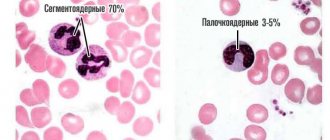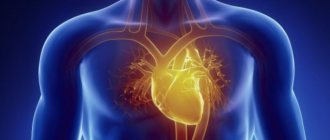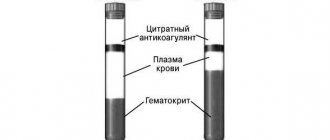Leukemia is a malignant disease that is often called blood cancer, which is not correct. It has another name - leukemia, which in Greek means “white cells”, hence the word leukemia. The bone marrow itself is responsible for the production of blood cells: red blood cells, platelets and white blood cells.
When affected by a tumor, immature mutated leukocytes begin to be produced in the blood, which constantly divide and completely fill the space, interfering with healthy cells. Also, mutated leukocytes do not perform their protective function.
Is leukemia curable or not?
The first question that arises for people who are faced with suspected blood cancer is whether leukemia can be treated or not.
Everyone knows that this is a serious and serious disease, but until it affects a specific person, few people delve into all the details. This is quite typical of human nature.
But in fact, information on this topic should not be neglected, since this disease is becoming widespread and, unfortunately, young children are often exposed to it.
There are proven medicinal methods, using which you can control the disease and achieve remission
Treatment
The treatment method is selected depending on many factors: the type of leukemia, its stage, the patient’s age and the characteristics of his health condition.
Self-medicating for leukemia means irretrievably missing the time needed to save a life.
Chemotherapy is almost always used at the first stage. The purpose of treatment is to destroy tumor cells. Either one chemotherapy drug is prescribed, or several at the same time. Both tablet and injection forms are used.
For each patient, the attending physician draws up an individual treatment regimen, taking into account all the features of a particular clinical case.
In practice, the chemotherapy program consists of 2 stages:
- Achieving remission - during treatment, as many tumor cells as possible are destroyed. This stage takes place in a hospital setting, maximum dosages are used, and nursing care for leukemia is included.
- Maintenance treatment to prevent relapse - at this stage the patient lives at home and periodically comes for medical examination and correction of therapy.
Our country uses world achievements in this area and applies new techniques:
- simultaneous administration of high doses of chemotherapy followed by stem cell transplantation allows achieving remission in the shortest possible time;
- transfusion of fresh lymphocytes from a donor;
- stem cell transplantation.
New drugs are being used:
- nucleoside analogues or substances that block the reproduction of viruses - are used for forms of leukemia that are resistant to traditional treatment;
- differentiating agents such as ARTRA - treats promyeloblastic leukemia well;
- monoclonal antibodies are cells whose “parent” is one cell clone; they accurately and effectively identify those tumor cells that need to be destroyed and deal with them.
In addition to medications, radiation therapy is also used, 2 types are used:
- external, this requires a linear accelerator;
- radioimmunotherapy or internal irradiation - a radioactive molecule is attached to monoclonal antibodies to reliably destroy leukemic formations.
Other original methods are emerging: for example, gene therapy has been approved in America, when modified T-lymphocytes themselves find and destroy leukemia cells.
Scientists from California have found that a vaccine against bacterial meningitis, namely against Haemophilus influenzae type B, reduces the risk of acute lymphoblastic leukemia in children.
Causes of the disease
Possible causes of the disease are:
- disturbances in the chromosomal apparatus and cell structure;
- exposure to elevated levels of radiation over a long period of time;
- interaction with toxic drugs and chemicals;
- bad habits, including smoking;
- after chemotherapy;
- genetic predisposition.
Leukemia in children
Lymphoblastic leukemia is the most common form in children; the disease is acute, although it may have a non-lymphoblastic form. Children from 2 to 5 years old are affected, boys somewhat more often. Acute leukemia is the most common cancer in children. Children with Down syndrome, congenital anemia and immunodeficiency are most at risk.
The danger is that the disease does not develop immediately, when the first manifestations are bleeding and hemorrhages in various organs. The heart suffers, leukemia cells permeate the tissues of the brain or spinal cord, and immunodeficiency develops.
Children are treated in the hematology oncology department, using combinations of chemotherapy drugs, vaccines and interferons, umbilical cord blood transfusions, and stem cell transplants. This tactic allows you to save up to 80% of children. Maintenance therapy is carried out with specific drugs.
Types of leukemia
Leukemias are acute and chronic. In the acute form, immature white cells begin to divide rapidly, and the disease develops in a short time.
Chronic leukemia progresses more slowly over several years, with white blood cells first maturing and then becoming abnormal.
The disease is classified depending on which cells are affected - lymphocytes, which do not contain granules, or myelocytes - young cells with a granular structure.
Thus, there are four types of leukemia:
- Acute myeloid. Both adults and children are susceptible to the disease.
- Acute lymphoblastic. Children are most often affected, although it also occurs in adults.
- Chronic lymphocytic. It usually develops in people over 55 years of age.
Myeloid leukemia. Characterized by rapid growth of myeloid cells, as a result they accumulate in the peripheral system.
A little about hematopoiesis
Hematopoiesis is a multistage differentiation, as a result of which full-fledged mature blood cells are formed, the mass of which makes up 7% of the body. Blood is the tissue that renews itself faster than all others: 109 leukocytes and 1011 erythrocytes are synthesized within one hour.
The bone marrow, which is a hematopoietic organ, begins its work from the 6th month of fetal development. After birth, blood cells are formed in almost all bones, but as they grow in tubular bones, the bone marrow is replaced by fatty marrow.
In an adult, blood cells are formed in the bone marrow of the following formations:
- sternum;
- pelvic bones;
- vertebrae;
- ribs;
- scull;
- the proximal or central ends of the femur and humerus.
In diseases of the hematopoietic system, the reverse process occurs: adipose tissue is replaced by hematopoietic tissue, and additional cells are synthesized in the spleen and liver.
Note! If you experience night sweats, fluctuations in body temperature without signs of infection, or decreased performance for no apparent reason, contact your doctor as soon as possible - it may be leukemia and urgent treatment is needed.
The main blood cell, which subsequently transforms into all others, is the hematopoietic stem cell (HSC). It produces 3 main types:
| Name | Function |
| Red blood cells | oxygen carriers |
| Leukocytes | protectors against infections |
| Platelets | main participant in the coagulation system, stops bleeding |
Cancer cells develop from different forms of leukocytes, displacing all others.
In leukemia, a mutated cell in the bone marrow gives rise to tumor growth, replacing normal blood cells. A leukemia cell behaves differently than a normal one - it practically does not wear out and does not die off at the end of its intended period, but replaces all the others. The composition of the blood changes, causing all organs to suffer. As the disease progresses, leukemic infiltrates form in various organs, primarily in the liver, lymph nodes and spleen. Tumor cells clog blood vessels, causing heart attacks of various locations to develop.
The classification of leukemia is important; not only treatment, but also prognosis depends on it.
Symptoms of leukemia
Symptoms of leukemia, especially at the beginning, are very nonspecific and these signs are easy to miss. We therefore recommend that you be very careful if you:
- feel severe weakness;
- you get tired quickly;
- suffer from headaches;
- don't want to eat;
- feel bone pain;
- noted that a rash and strange bruises appeared;
- nosebleeds appeared, gums bleed;
- losing weight;
- you often suffer from infectious diseases.
Of course, one or two of these symptoms can simply be attributed to workload, for example. However, do not miss a serious illness, do not risk your life - once you notice the signs, then come to us for diagnosis. The sooner you begin treatment for blood diseases, the greater the chances of your recovery.
3.Leukemia symptoms
Leukemia symptoms depend largely on what type of leukemia a person develops, but common leukemia symptoms include:
- Increased temperature and increased sweating at night;
- Headache;
- Tendency to bruising and bleeding;
- Bone pain or joint pain;
- Swelling or pain in the abdomen due to an enlarged spleen;
- Enlarged lymph nodes in the armpits, neck, or groin;
- Frequent infections and illnesses;
- Feeling very weak and tired;
- Weight loss.
About our clinic Chistye Prudy metro station Medintercom page!
Stages
Separately, it is necessary to consider the main stages of leukemia.
- Initial. Most often diagnosed in patients who suffer from anemia.
- Expanded. All the symptoms are already showing up here.
- Remission. May be complete or incomplete. It is characterized by an increase in blast cells by a maximum of 5% in the bone marrow (in their absence in the blood).
- Relapse. It can develop both in the bone marrow and other organs. It is worth saying that each subsequent relapse is more dangerous than the previous one.
- The last one. In this case, the patient develops ulcerative-necrotic processes, and suppression of hematopoiesis occurs.
On a note
Achievements in domestic oncohematology, primarily in children, became possible thanks to the state’s attention to this branch of medicine.
41% of the funds allocated to finance the state program “7 nosologies” (which is $1.16 billion) are allocated to the treatment of patients with hematological malignancies (malignant blood diseases, which also include childhood leukemia).
In Russia, unrelated bone marrow donation programs are just beginning - such transplants began to be performed only 10 years ago. On a national scale, there are negligible numbers of them - no more than 70–80 per year. In total, 13 clinics in the country are licensed to perform transplantation, and there are 70–75 board-certified hematologists, oncologists, and transfusiologists who can perform the procedure. One of the largest transplant departments is the Scientific and Clinical Center for Pediatric Hematology, Oncology and Immunology named after Dmitry Rogachev, which opened in 2011 in Moscow.
Chances of recovery
Currently, the diagnosis of leukemia is not a death sentence, as it was before. The answer to the question whether leukemia is curable depends on certain factors:
- types of disease;
- timely diagnosis;
- the nature of tissue and organ damage;
- age characteristics;
- other possible risks.
Thus, it is important to monitor your health carefully and closely. At the moment, specialists do not have a maximum guarantee that leukemia can be treated, but thanks to modern medicine, there are a considerable number of methods that make it possible to extend the patient’s life by several decades.
Causes
The reasons why leukemia occurs are not completely clear, but researchers are discovering new facts.
Thus, the journal Proceedings of the National Academy reports that leukemia appeared about 20 million years ago, the first victims were bats, and the immediate cause was the deltaretrovirus.
The following reasons have now been proven:
- heredity or family mutations;
- exposure to ionizing radiation;
- influence of chemicals;
- smoking.
Treatment of acute forms of leukemia
Acute lymphocytic leukemia in young children is cured in 95%. Almost 70% of those who have recovered from the disease have no signs of the disease for at least five years.
In the treatment of acute lymphoblastic form, chemotherapy based on three drugs is used. If a relapse of the disease occurs after using chemotherapy, the doctor advises using a stem cell transplant if indicated; the decision depends on the patient.
When treating the myeloid form, strong drug therapy is used in several courses. Bone marrow transplantation is sometimes used. The higher the patient's age, the lower the likelihood of recovery.
Failure in the immune system
Is it possible to predict the risk of developing leukemia? Unfortunately no. “99% of leukemias are completely random events,” says Deputy General Director for Scientific Work of the Federal Research Center for Pediatric Hematology, Oncology and Immunology named after Dmitry Rogachev, Director of the Institute of Hematology, Immunology and Cell Technologies (IGICT), Doctor of Medical Sciences, Professor Alexey Maschan . — In children, the most rapidly developing system is the immune system, and a failure in its functioning in some people leads to the development of leukemia. Every year, 4 cases of acute leukemia are registered per 100 thousand children.”
Where to go Bone marrow transplantations for children and adolescents are carried out in 13 Russian medical centers. The leading ones are located in Moscow - Federal Scientific Center for Children's and Orthopedics Orthopedics named after. Dmitry Rogachev, Russian Children's Clinical Hospital, Cancer Center named after. N. N. Blokhina. In St. Petersburg - St. Petersburg State Medical University named after. Academician I.P. Pavlov, Institute of Pediatric Hematology and Transplantology named after Raisa Gorbacheva. There are centers in Yekaterinburg and Nizhny Novgorod.
Experts recommend paying attention to the following symptoms and changes in the child’s well-being:
- the unreasonable appearance of bruises, small hemorrhagic rash - not because the child hit himself, but just like that;
- pallor, increased abdominal size;
- the appearance of strange formations on the body, enlarged lymph nodes;
- changes in blood tests;
- There may be various pains - headaches, in the stomach, but this is an optional symptom.
The first person parents should contact for advice is the local pediatrician; he will decide whether the child needs a consultation with a hematologist.
“If the fears are not unfounded, the child is transferred to the regional children's clinical hospital, to hematologists. Regional hospitals decide whether they can cope with this disease on their own: whether they have the necessary equipment and personnel,” says Elena Skorobogatova, head of the bone marrow transplantation department of the Russian Children’s Clinical Hospital of the Russian Ministry of Health, Doctor of Medical Sciences . “If it can’t be dealt with locally, the region turns to one of the federal clinics where there is a bone marrow transplant department. My advice: if your child is diagnosed with acute leukemia, do not go to private clinics, use the public network. Don't waste your time and money! "
Treatment of chronic leukemia
Unlike the acute form of the disease, the chronic form does not require such urgent intervention. It develops more slowly and treatments vary. First of all, there is an observation period. In the early stages, the symptoms are almost invisible, but medical supervision is a must.
Such patients are also prescribed the usual treatment, but in the case of transplantology, cells can be taken from the patient’s body. Biological therapy is also used to help the body improve its protective functions. Conventional treatment methods are also used for patients.
Diagnostics
Diagnostics includes several points:
- collecting information about lifestyle and the development of the disease;
- blood test for cancer;
- clinical examination;
- bone marrow analysis;
- lymph node biopsy;
- additional instrumental methods - ultrasound, MRI, CT, positron emission tomography.
Quite often, leukemia is detected with a simple general blood test, and long before the first clinical manifestations.
Blood parameters for leukemia are as follows:
- decreased hemoglobin levels;
- decrease in the number of red blood cells;
- decreased hematocrit or blood cell to plasma ratio;
- significant - 4-5 times - drop in platelet levels;
- change in the number of lymphocytes: either too high or too low, but never normal;
- complete absence of some forms of lymphocytes, in particular eosinophils and basophils;
- leukemic failure or the most striking sign of blood cancer, which manifests itself in the fact that there are many young cells in the blood, but only a few mature forms capable of performing their functions;
- significant increase in erythrocyte sedimentation rate.
Such a blood test alarms any doctor, and additional studies are prescribed.
A general blood test, performed for preventive purposes or during a routine examination, detects leukemia at an early stage and makes it possible to carry out adequate treatment on time.
The next stage of diagnosis is sternal puncture or sampling of bone marrow from the sternum. Sometimes bone marrow is taken from the pelvic bones.
The manipulation is simple and is performed in laboratory conditions. Before the procedure, you should not eat or drink for 2 hours.
After local anesthesia, in the supine position, the sternum is punctured with a Kassirsky needle - a tubular needle with a nut to limit the depth of penetration, a rod to close the lumen and a handle.
After the puncture, a regular syringe is attached to the needle and up to 0.3 ml of bone marrow is taken, which is sent for cytological examination. The puncture site is covered with an adhesive bandage.
If more than 5% of immature blood cells or, otherwise, blasts are detected, the diagnosis of leukemia is confirmed. Unfortunately, at the height of the disease there are much more of these cells, up to several tens of percent.
Attention is also paid to the lymph nodes - too enlarged ones sometimes have to be removed surgically, especially if they compress nerves or blood vessels. The removed tissues of the node are also subject to histological examination.
Additional research methods that visualize accumulations of leukemia cells are used to examine deep-lying organs: liver, spleen, pelvic bones. Computer, magnetic resonance or positron emission tomography is used.
Based on the results of the examination, treatment is prescribed.
Treatment methods
The method of combating the disease is selected based on its stage and form. For chronic leukemia, therapy is used that is aimed at stopping the development of the disease, maintaining the body's protective functions and preventing complications. In addition, many patients are interested in whether acute blood leukemia is curable or not. It is worth saying that with a competent approach, the symptoms of this form of the disease can also be eliminated. For this use:
Chemotherapy. It destroys cancer cells.
Radiation therapy. It destroys affected cells using x-ray radiation.
Stem cell transplant. With this method, the formation of healthy cells is restored.
Before proceeding with surgery, chemotherapy is administered. It is necessary to make room for new, healthy bone marrow cells.
4.Diagnostics and treatment
To find out if a patient has leukemia, the doctor will ask questions about the symptoms of the disease and existing health problems. In addition, a general physical examination is carried out - the doctor will look to see if the lymph nodes, liver or spleen are enlarged. In any case, if leukemia is suspected, a blood test is necessary. A blood test for leukemia will show high levels of white blood cells and low levels of other blood cells.
If your blood test results are abnormal, your doctor may do a bone marrow biopsy. This test will examine bone marrow cells. Typically, a bone marrow biopsy makes it possible to accurately diagnose leukemia and its type, and to select the optimal treatment for leukemia.
Preventive measures
To avoid pathology it is necessary:
- choose a place of residence with as favorable an environment as possible,
- patients whose relatives had cancer should donate blood for examination every six months;
- the same recommendation applies to people who have genetic defects that exceed the norm.
Leukemia is a malignant disease often called blood cancer. When the disease occurs, the red bone marrow produces leukemia cells - abnormal blood cells. Scientists have not yet established why this happens in the human body.
Related posts:
- Chances of surviving stomach cancer Stomach cancer occurs in the tissues of the mucous membrane of this digestive organ….
- Tumors in the oral cavity Tumors can occur in any type of tissue in the oral cavity...
- Chemotherapy for cancer: can such treatment affect the psyche? The condition of a cancer patient after undergoing a course of chemotherapy is quite serious...
- 6 Superfoods That Reduce Your Risk of Cancer The human body is made up of many different types of cells. Usually they...
2. Causes of leukemia
The exact causes of leukemia are still not known. But certain things have been found to increase the risk of developing certain types of leukemia. Risk factors are:
- Exposure to large amounts of radiation;
- Exposure to certain chemicals (eg at work), such as benzene;
- Having undergone some types of chemotherapy to treat other types of cancer;
- Down syndrome and other genetic problems;
- Smoking.
However, these risk factors are quite arbitrary. Most people who are at potential risk do not get leukemia. And most people who have leukemia are not at risk for any known factor.
Visit our Oncology page
What happens after treatment of acute leukemia?
After completion of treatment for acute leukemia, dynamic observation in the clinic is necessary. Such observation is very important, as it allows the doctor to monitor possible relapse (return) of the disease, as well as side effects of therapy. It is important to tell your doctor immediately if you experience any symptoms.
Typically, relapse of acute leukemia, if it occurs, occurs during treatment or shortly after its completion. Relapse develops very rarely after remission, the duration of which exceeds five years.
What causes acute leukemia and can it be prevented?
A risk factor is something that increases the likelihood of disease. Some risk factors, such as smoking, can be eliminated. Other factors, such as age, cannot be changed.
Smoking is a proven risk factor for acute myeloid leukemia (AML). Although many people know that smoking causes lung cancer, few realize that smoking can affect cells not directly exposed to smoke.
Cancer-causing substances found in tobacco smoke enter the bloodstream and spread throughout the body. One fifth of AML cases are caused by smoking. People who smoke should try to quit smoking.
There are some environmental factors that have been linked to the development of acute leukemia. For example, long-term exposure to gasoline is a risk factor for AML, and exposure to high doses of radiation (atomic bomb explosion or nuclear reactor incident) increases the risk of AML and acute lymphoblastic leukemia (ALL).
People who have had other cancers and were treated with certain anticancer drugs are at increased risk of developing AML. Most of these cases of AML occur within 9 years of treatment for Hodgkin's disease (lymphogranulomatosis), non-Hodgkin's lymphoma (lymphosarcoma), ALL, or other malignancies such as breast and ovarian cancer.
There is some concern regarding high-voltage transmission lines as a risk factor for leukemia. According to some data, in these situations the risk of leukemia is not increased or increased slightly. What is clear is that most cases of leukemia are not associated with high-voltage transmission lines.
A small number of people with very rare diseases or the HTLV-1 virus have an increased risk of developing acute leukemia.
However, most people with leukemia have no identified risk factors. The cause of their illness remains unknown to this day. Due to the fact that the cause of leukemia is unclear, there are no methods of prevention, with the exception of two important points: avoid smoking and contact with substances that cause cancer, such as gasoline.
Circulatory and lymphatic systems
To understand the different types of leukemia, it is helpful to have basic information about the circulatory and lymphatic systems.
Bone marrow is the soft, spongy, inner part of bones. All blood cells are produced in the bone marrow. In infants, bone marrow is found in almost all the bones of the body. By adolescence, bone marrow is stored mainly in the flat bones of the skull, shoulder blades, ribs, and pelvis.
Bone marrow contains blood-forming cells, fat cells, and tissues that help blood cells grow. Early (primitive) blood cells are called stem cells. These stem cells grow (mature) in a specific order and produce red blood cells (erythrocytes), white blood cells (white blood cells) and platelets.
Red blood cells carry oxygen from the lungs to other tissues of the body. They also remove carbon dioxide, a waste product of cellular activity. A decrease in the number of red blood cells (anemia, anemia) causes weakness, shortness of breath and increased fatigue.
White blood cells help protect the body from germs, bacteria and viruses. There are three main types of leukocytes: granulocytes, monocytes and lymphocytes. Each type plays a special role in protecting the body against infection.
Platelets prevent bleeding from cuts and bruises.
The lymphatic system consists of lymphatic vessels, lymph nodes and lymph.
Lymphatic vessels resemble veins, but they do not carry blood, but a clear liquid - lymph. Lymph consists of excess tissue fluid, waste products and immune system cells
Lymph nodes (sometimes called lymph glands) are bean-shaped organs located along the lymphatic vessels. Lymph nodes contain cells of the immune system. They can increase in size more often during inflammation, especially in children, but sometimes their increase can be a sign of leukemia, when the tumor process has spread beyond the bone marrow.
Top
How is acute leukemia diagnosed?
Leukemia can be accompanied by many signs and symptoms, some of which are nonspecific. Please note that the following symptoms most often occur with diseases other than cancer.
Common symptoms of leukemia may include fatigue, weakness, weight loss, fever, and loss of appetite.
Most symptoms of acute leukemia are caused by a decrease in the number of red blood cells as a result of the replacement of normal bone marrow, which produces blood cells, with leukemia cells. As a result of this process, the patient's number of normally functioning red blood cells, white blood cells and platelets decreases.
Anemia (anemia) is the result of a decrease in the number of red blood cells. Anemia leads to shortness of breath, fatigue and pale skin.
A decrease in the number of white blood cells increases the risk of developing infectious diseases. Although leukemia patients may have very high white blood cell counts, these cells are not normal and do not protect the body from infection.
A low platelet count can cause bruising, bleeding from the nose and gums.
Spread of leukemia beyond the bone marrow to other organs or the central nervous system can cause various symptoms such as headache , weakness , seizures , vomiting , and disturbances in gait and vision .
Some patients may complain of pain in the bones and joints due to their damage by leukemia cells.
Leukemia can lead to an increase in the size of the liver and spleen . If the lymph nodes are affected, they may become enlarged.
In patients with AML, gum disease causes swelling, tenderness, and bleeding. Skin lesions are manifested by the presence of small multi-colored spots that resemble a rash.
In T-cell type ALL, the thymus gland is often affected . A large vein (superior vena cava), which carries blood from the head and upper extremities to the heart, runs next to the thymus gland. An enlarged thymus gland can put pressure on the trachea, causing coughing, shortness of breath, and even suffocation.
When the superior vena cava is compressed, swelling of the face and upper extremities is possible (superior vena cava syndrome). This can cut off the blood supply to the brain and be life-threatening. Patients with this syndrome should begin treatment immediately.
The presence of some of the above symptoms does not mean that the patient has leukemia. Therefore, additional studies are carried out to clarify the diagnosis and, if leukemia is confirmed, its type.
Blood test.
Changes in the number of different types of blood cells and their appearance under a microscope may suggest leukemia. Most people with acute leukemia (ALL or AML), for example, have too many white blood cells and not enough red blood cells and platelets. In addition, many white blood cells are blast cells (a type of immature cell that does not normally circulate in the blood). These cells do not perform their function.
Bone marrow examination.
A small amount of bone marrow is removed using a thin needle for testing. This method is used to confirm the diagnosis of leukemia and evaluate the effectiveness of treatment.
Lymph node biopsy.
In this procedure, the entire lymph node is removed and then examined.
Spinal tap.
During this procedure, a thin needle is inserted in the lower back into the spinal canal to obtain a small amount of cerebrospinal fluid, which is examined for leukemia cells.
Laboratory research.
To diagnose and clarify the type of leukemia, various special methods are used: cytochemistry, flow cytometry, immunocytochemistry, cytogenetics and molecular genetic studies. Specialists study bone marrow, lymph node tissue, blood, and cerebrospinal fluid under a microscope. They evaluate the size and shape of the cells, as well as other characteristics of the cells, to determine the type of leukemia and the degree of maturity of the cells.
Most immature cells are blast cells, unable to fight infection, which replace normal mature cells.
- X-rays are taken to identify tumor formations in the chest cavity, damage to bones and joints.
- Computed tomography (CT) is a special X-ray method that allows you to examine the body from different angles. The method is used to detect lesions in the chest and abdominal cavities.
- Magnetic resonance imaging (MRI) uses strong magnets and radio waves to produce detailed images of the body. The method is especially suitable for assessing the condition of the brain and spinal cord.
- Ultrasound examination (ultrasound) makes it possible to distinguish tumor formations and cysts, as well as the condition of the kidneys, liver and spleen, and lymph nodes.
- Lymphatic and bone system scan: In this method, a radioactive substance is injected intravenously and accumulates in the lymph nodes or bones. Allows differentiation between leukemic and inflammatory processes in lymph nodes and bones.








